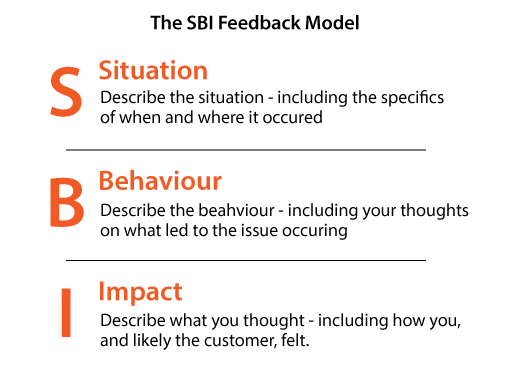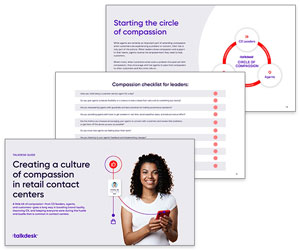We share great ideas for building report with angry customers, starting with a video before sharing even more expert advice.
Handling Angry Customers – A Great Video
Emotional intelligence is a great skill to have in almost every profession, and customer service reps are no exception, as they often have to deal with emotionally challenging situations.
One common situation is dealing with angry customers. So we asked Sandra Thompson, Founder of Exceed All Expectations, to use her expertise and customer service experience and put together a great online presentation on the subject.
In the video, Sandra discusses how you can build rapport with angry customers by doing a number of things, including:
- Understanding the cause of the customer’s emotion
- Managing our own emotions and guarding against “emotion contagion”
- Taking some time to RESPOND – not react
- Being compassionate to yourself
- Controlling and practising your breathing
Below are even more great best practices for rapport building with angry customers.
Be Wary of the Angry Customer Label

Neil Martin
Neil Martin, Director at The First Word, told us: “The words we use to describe our customers shape how we feel about them.”
“How we feel shapes the language we use and frames the conversation.”
This point is particularly important if you have a strategy around escalating angry customers.
If the person escalating the call says: “I’ve got an angry customer on line two,” immediately we are filled with a sense of dread that impacts our approach to the call. We might even enter “fight mode”.
However, if we were to describe the customer as “anxious”, we would approach the call differently and with greater empathy.
So, we have to step in and be aware of this, because otherwise our language and emotion will take a hold of our language and tone. Take the two emails below as an example.
When we think of the customer as “angry”, it is natural to enter fight mode and write an email like this:
Dear Mr Customer,
We apologize for the delay in our response.
You state you remain unhappy and believe you are entitled to a partial refund. The concerns you raised have now been fully addressed. However, on this occasion there was a shortfall in our service. Therefore, in order to resolve your complaint, I am willing to credit your account with £50 as a gesture.
Regards,
John
However, if we were instead to think of the customer as “anxious”, we will naturally enter empathy mode and respond like this:
Hi Mr Customer,
I’m very sorry you’ve had so many problems with our service recently.
I understand why your experience left you feeling anxious, especially as it took us longer than it should to put things right for you.
To make up for your experience, I’d like to top up your account with £50. Or, if you prefer, I can send you a cheque for £50.
All the best,
John
The key here is, when you’re looking back through call and screen recording, to think about whether the way that the advisor is feeling is influencing – in a positive or negative way – the kind of language that they are using.
Train Self-Regulation
There is great importance in self-regulating your emotions when dealing with angry customers and there are number of training activities to help your advisors do this.
For example, you can undertake a coaching exercise where you role-play situations where advisors are told to think that everyone they speak to is “just like them”.
Undertake a coaching exercise where you role-play situations where advisors are told to think that everyone they speak to is “just like them”.
By this teaching this, we encourage advisors to consider the customer to have the same worries, concerns, issues as them. This can really help people to empathize with one another.
This technique also helps us to guard against “emotional contagion” which, as Sandra Thompson describes in the video, means that you catch emotions from others.
“The best thing to do if you ‘catch an emotion’ is to think of yourself as a resilient individual who chooses to be non-stick,” says Sandra Thompson.
We also need to always remember there is a larger context behind the customer complaint, which is why the customer is likely so angry. We must recognize this if we want to build rapport in an authentic way.
There are some more exercises to help specifically build emotional intelligence in our article: 9 Fun Customer Service Training Activities
Demonstrate Empathy
It can sometimes be easier to empathize with people when you are face to face with them as most communication is body language.
With that being said, in a contact centre you can empathize in a number of ways to help an angry customer to calm down.
Repeat what the customer has said to you in your own words to prove that you have been listening.
For example: “You can repeat what the customer has said to you in your own words to prove that you have been listening, while you are checking that you have understood what they have said,” says Sandra.
Depending on the guidelines in your organization, you may also consider saying things like:
- “That must have been terrible”
- “That sounds like it has been very difficult for you”
- “I’m sure I would feel the same in your situation”
If you use empathy statements in this way, the customer can see that you are attempting to see things from their perspective.
Find out how to train empathy in the contact centre by reading our article: How to Coach Empathy in the Contact Centre – With Three Training Exercises
Accept That You Cannot Control Everything
The only thing you have control over is the way you behave when dealing with angry customers.
“How they behave, what they say and how they react to you is completely out of your control – but if you were to empathize with them, you may be able to influence their behaviour,” adds Sandra.
To influence customer behaviour, you may be able to use a particular tone and alter your language to help build rapport with them.

Knowing when to change your tone and language comes back to our overarching skill of emotional intelligence.
But knowing when to change your tone and language comes back to our overarching skill of emotional intelligence. This is a skill that is more valuable than IQ when it comes to developing both personal and professional relationships – according to research by Emotional Intelligence author Daniel Goleman.
However, when it comes to dealing with angry customers, it’s not a case of one being better than the other.
As Sandra says: “You do need a certain level of IQ to be able to develop something called ‘emotional granularity’, which means the way you identify and label the emotions you feel.”
To find out how you can change up your language to build rapport with angry customers, you can read our article: The Right Words and Phrases to Say to an Angry Customer
Remove Pressures From Advisors
There may be pressures from management, which you might not realize, which hinder advisors from remaining calm and building rapport when dealing with angry customers.
A classic example is if advisors feel pressure to reduce average handling time (AHT), but the customer just won’t stop venting at them.
Ideally, advisors would be given the opportunity and feel comfortable to have a conversation with management if the pressure they are applying is too great and is causing anxiety.
As an advisor, in this situation, there are still some helpful little tips to help you if you ever feel as though you are being put in this situation.

Sandra Thompson
“You could consider a ‘positive outlook’ and decide that there are opportunities available to you rather than focusing on the pressure,” says Sandra.
“Also, you could breathe into the moments when you feel the pressure – which means that you can choose not to react to the pressure, but rather to respond in the way you want to show up.”
However, contact centres should set clear and fair expectations to advisors as to what is expected of them. This means not pressuring on AHT or, even worse, service level.
Give Advisors Feedback in a Constructive Way
To help advisors better build rapport with angry customers, we need to learn to give both positive and constructive feedback, so they are more receptive to our advice.
Giving good feedback starts with considering: what are the characteristics of the people you are talking to? You may want to give introverts feedback more modestly than extraverts, for example.
Also, there are a number of feedback models that will help you to give feedback in a structured way. The SBI feedback model (Situation, Behaviour, Impact) is one such example and is outlined below.

When giving feedback regarding an interaction with a customer, remember that the feedback that you are giving them may not be easy for them to carry out. You may need to deal with the “fear” they are experiencing with the change you are asking them to make.
If you can explain that there is no threat and these are the benefits to them, advisors will be more appreciative of your advice – especially if you role-play a couple of angry situations through with them.
For more model examples for offering feedback to advisors, read our article: Contact Centre Coaching Models: Which Is Best for Your Coaching Sessions?
5 Simple Ideas for Rapport Building With Angry Customers
We reached out to our readers and asked them: which strategies for dealing with angry customers have worked well in your contact centre?
Below are our favourite five, which we hope will help you build rapport with angry customers.
1. Let Them Vent
If you have a customer who is upset or angry and they are expressing these feelings to you – let them! They are not going to be able to listen until they remove the emotion.
You can say “I understand why you are upset and I would be too. I’m happy to help get you straightened out.”
2. Share Your Experiences
We hold a weekly debrief for those who want to (it’s not a requirement if people don’t want to come), where colleagues can come to talk through either difficult calls, how they are feeling or issues in the workplace.
Sometimes we switch this to do fun things – quizzes, drawing or, my favourite, playing with Play-Doh. This helps to motivate and ensure mental/emotional resilience.
3. Use the HEAT Acronym
Spreading quotes and acronyms across the contact centre can be a great way to reinforce key messages and values.
One acronym that we use for rapport building with angry customers is “HEAT”. This stands for:
H – Hear and listen to what the client is saying.
E – Empathize with the client’s complaint.
A – Apologize for the incident.
T – Take ownership and find a solution to the concern or complaint.
4. Introduce a “Personal Code”
We have introduced a “Personal” code which allows agents a minute or two to gather themselves after a difficult call and grab a drink.
With this we have found a decrease in wrap time as advisors were previously stretching this time for a rest after challenging contacts.
5. Don’t Neglect Employee Well-Being
We always have a few mental health champions at our place of work as the well-being of the employees is just as important as the well-being of our customers.
When dealing with difficult or angry customers, we ensure each advisor has a go-to person to discuss difficult moments with.
For more on ensuring staff well-being in the contact centre, read our article: A Guide to Improving Mental Health in the Contact Centre
Final Thoughts
Rapport building with angry customers is a difficult task, but we have presented you with a number of techniques in the article to help calm customers down and offer great customer service.
Avoiding the “angry customer label”, training self-regulation and demonstrating empathy are all good examples that are great to keep in mind.
But the last point for us to focus on – which a number of our readers brought up – is to remember the importance of employee well-being. Giving your team the chance to open up about their angry customer encounters and coaching resilience (as well as empathy) is an important part of this.
Good luck!
For more on the topic of rapport building with angry customers, read our articles:
- Top Tips for Building Rapport on the Telephone
- 27 Effective Ways to Build Customer Rapport
- The Top 12 Acknowledgement Statements for Customer Service
Author: Robyn Coppell
Reviewed by: Megan Jones
Published On: 8th Jul 2020 - Last modified: 25th Jan 2024
Read more about - Skills, Angry Customers, Editor's Picks, Empathy, Rapport





































